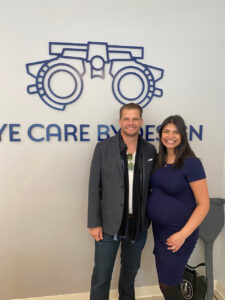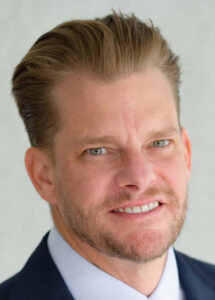
Dr. Steinmetz with Azzrah Thobani, OD, who cold-started her practice. Dr. Steinmetz says that at the beginning, it’s important to offer easy-to-access routine eyecare, and to accept a wide range of patient insurances.
Keys to launching a profitable cold-start practice.
By Robert J. Steinmetz OD, FAAO
Jan. 31, 2024
Here is a hot stock tip for a motivated optometric investor: do you want an investment you can fully control, builds long-term equity, is completely customizable and involves doing what you love? Cold-start an optometric practice.
Is Cold-Starting a Good Risk?
It is not for everyone, but I can speak from experience and can confirm that for many, it can be well worth the risk. I have personally cold-started 11 private practices in a saturated, urban market. My team and I, at iCare Advisors, have helped cold-start more than 300 practices across the country from inception into profitability.
The track record of cold-start optometric practice is undeniable, which is why banks are willing to invest in optometry, even in a challenging lending environment and uncertain economic times.
Our cold-start doctors are brave visionaries who are motivated and unapologetically independent. Many of our clients are female, part of a minority group, and are uniquely diverse, which mirrors the demographic composition of the modern optometric profession.
They represent the new face of private practice and will carry the torch forward to lead the way for those who follow. Their stories are inspiring, and their financial success is matched only by their personal fulfillment.
While the optometric world has been abuzz with talk of the explosion of private equity, our cold-start optometric practices have quietly flourished over the past decade accounting for over $150 million in sales in 2023 alone.
This collective achievement would rank them among the top 15 U.S. optical retailers this past year. These practices boast an average revenue per patient of $458 and consist of a wide range of specialties, including primary care family practices, high-end opticals, dry eye specialists, scleral lens luminaries and myopia management experts.
While the missions of the practices we work with vary, their goals are distinct and self-defined. Our database is comprehensive, encompassing small-town, farm-town, urban, rural and even hobby practices. It offers a genuine representation of our cold-starts nationwide.
Some will achieve $1 million in year two while others cherish their independence and have no plans to exceed $750,000 in their current location. Some enjoy working a three-day workweek, spending quality time with their families, while others remain focused on financial achievements. Their success may be defined differently by others, but they each find fulfillment in their own unique way.
Essential First Step: Building Patient Volume Though Trusted Research
One thing is for certain: to achieve success, you need patient volume. Surprisingly, most cold-start practices only see approximately 50 patients in their first month of business, which is why sufficient working capital and realistic expectations are important. Opening lean while executing your mission is key. Marketing dollars are at a premium in the early stages of practice and word-of-mouth and low-cost referral sources are crucial to survival.
Cold-Start Quick Tips
Ask the right questions and perform your due diligence. There are advisors who can help you reach your goals faster with less risk. Look to those who have been in your shoes and shared your life experiences. They understand the clinical grind and the “eat what you kill” mentality. They have risked it all themselves to build something from scratch with significant student debt and little knowledge of business, construction, leases, credentialing and third-party insurances.
Be cautious. There are always tales of unqualified success cloaked in good fortune, but showered in love and respect by overzealous keyboard warriors. The truth is that cold-starting is hard. It is not glamorous, nor is it for everyone.
Don’t be afraid of criticism. The best investment you can make is the investment in yourself. You already did this with your education, and you can now leverage your efforts into an investment that you can control.
Do not rely on an N of 1. No great research study has ever started with the sentence: “I had this one patient.”
Third-Party Insurance is Critical for Early Success
Third-party insurance is essential in the early stages of a cold-start practice operating on a fixed budget with conventional lending sources. Access to third-party vision and medical insurance panels has become problematic and needs to be navigated at the county and even municipality level.
Data from our cold-start clients show that VSP accounts for 33 percent of all comprehensive exam visits, while EyeMed accounts for 28 percent. This can vary by region, with VSP being more present in California, where it was founded. Davis Vision and Superior Vision can account for over 25 percent of patients in some urban markets with a high number of government employees.
EyeMed is the fastest-growing vision insurance in the country and can include more than 50 percent of insured patients in metro environments. Membership on these panels can be vital to early cold-start success and some doctor alliances provide better access to restricted panels than others. This must be taken into consideration when up to one-third of your patient volume is dependent on a single insurance panel membership.
Patients are more likely to visit providers that accept their insurance and often locate their vision care provider by referencing their insurance provider’s website. Cold-starts, by definition, do not have an established patient base. They need time to cultivate a relationship with their patients, earn their trust and secure their loyalty. We all want more private-pay patients, and taking vision insurance does not prevent you from servicing private-pay patients or prevent you from focusing on individualized care.
Accepting insurance only allows for greater access to private pay through word-of-mouth referrals and happy insurance patients posting positive online reviews. An empty chair earns no revenue. Through proper third-party vision and medical insurance strategies, all of these patients are profitable and provide an important food source to feed a growing practice.
Teach a (Wo)man to Fish…
Our approach for a fast start is simple: cast a wide net, but fish in proven, productive grounds defined by optometric geospatial analytics. Casting a wide net with smaller openings allows greater access to the general population in a given area. While these fish (i.e. patients) may be smaller than others, they are still captured by the reduced size holes in your ever-compassionate net. These small fish can now be used as bait to attract larger fish that will feed your family.
Other Articles to Explore
Larger fish swim in schools and often associate with one another. Draw on their influence and expertise to guide the school into your net of comprehensive care so you can treat their family as you would your own children. Don’t discriminate. You have mouths to feed and chair time to spare.
One fish in an otherwise empty net is better than no fish at all. Nourish yourself with what the sea provides. Specialization and purposeful selection takes time and slow steady growth. If you specialize too early, and cast a net with large gaps, you will be waiting longer for your next meal.
In the beginning, you are hungry for success, but you need to be patient and embrace what is provided by enrolling in as many vision and medical insurance plans that will allow you on the panel. In the future, you can cast a wider net with larger holes to capture the fish you prefer that will sustain your practice long term. You may decide to give the smaller net to your associate or relocate it on another boat to fish an entirely different population in a community nearby. Missions and populations change, and you will need to evolve with them.
The secret is that there is no secret. There are no shortcuts. Hard work is required.
Here is my stock tip: If I were to invest, I would place a bet on every one of you reading this article who chooses to invest in themselves and their community. With proper support and guidance, your financial and emotional return will be far greater than any stock you can purchase or hot tip you will ever receive. Buy optometry.
 Robert J. Steinmetz OD, FAAO, is Co-Founder/Owner at iCare Advisors, LLC. To contact him: drsteinmetz@icareadvisors.com
Robert J. Steinmetz OD, FAAO, is Co-Founder/Owner at iCare Advisors, LLC. To contact him: drsteinmetz@icareadvisors.com

























